We actually have three woodland-type areas, in other words, areas where we grow some woodland plants under and near some trees. Even though these areas are quite small, their spring ephemerals (plants that bloom only fleetingly in the spring) are especially welcome after our long Central New York winters.
Back yard woodland

This is our back yard woodland (actually only the back area of the photo). The small hill is made from the dirt excavated from the pond, so the soil wasn’t very good. Still, most things have grown pretty well, and as the fallen leaves decay each year, the soil gets more forest-like. At first, we also have put some of our composted leaves on this area, but this no longer seems necessary.
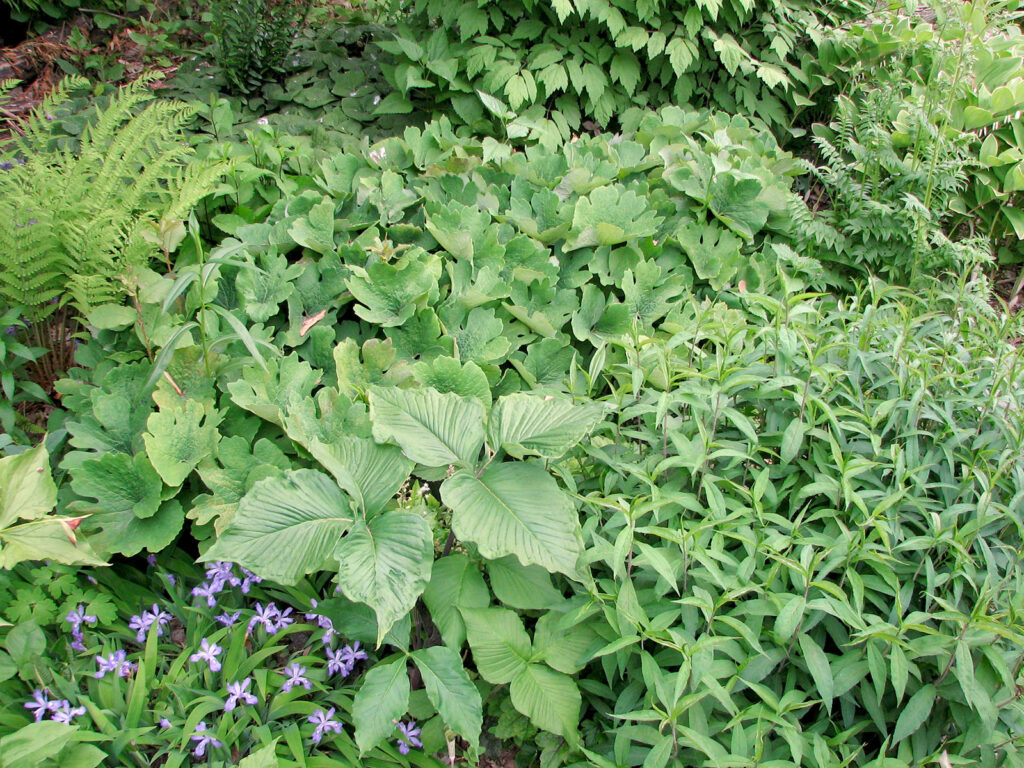
We have some trilliums (Trillium grandiflorum), Jack-in-the-pulpit (Arisaema triphyllum), foamflowers (Tiarella cordifolia), black cohosh (Cimicifuga racemosa), false Solomon’s seal (Smilacina racemosa), bloodroot (Sanguinaria canadensis), wild ginger (Asarum canadense), a variety of ferns, and some other flowers.
They don’t call them ephemeral for nothing! We enjoy the flowers, however briefly they bloom, but we’ve also come to greatly enjoy their beautiful foliage.
First front yard woodland
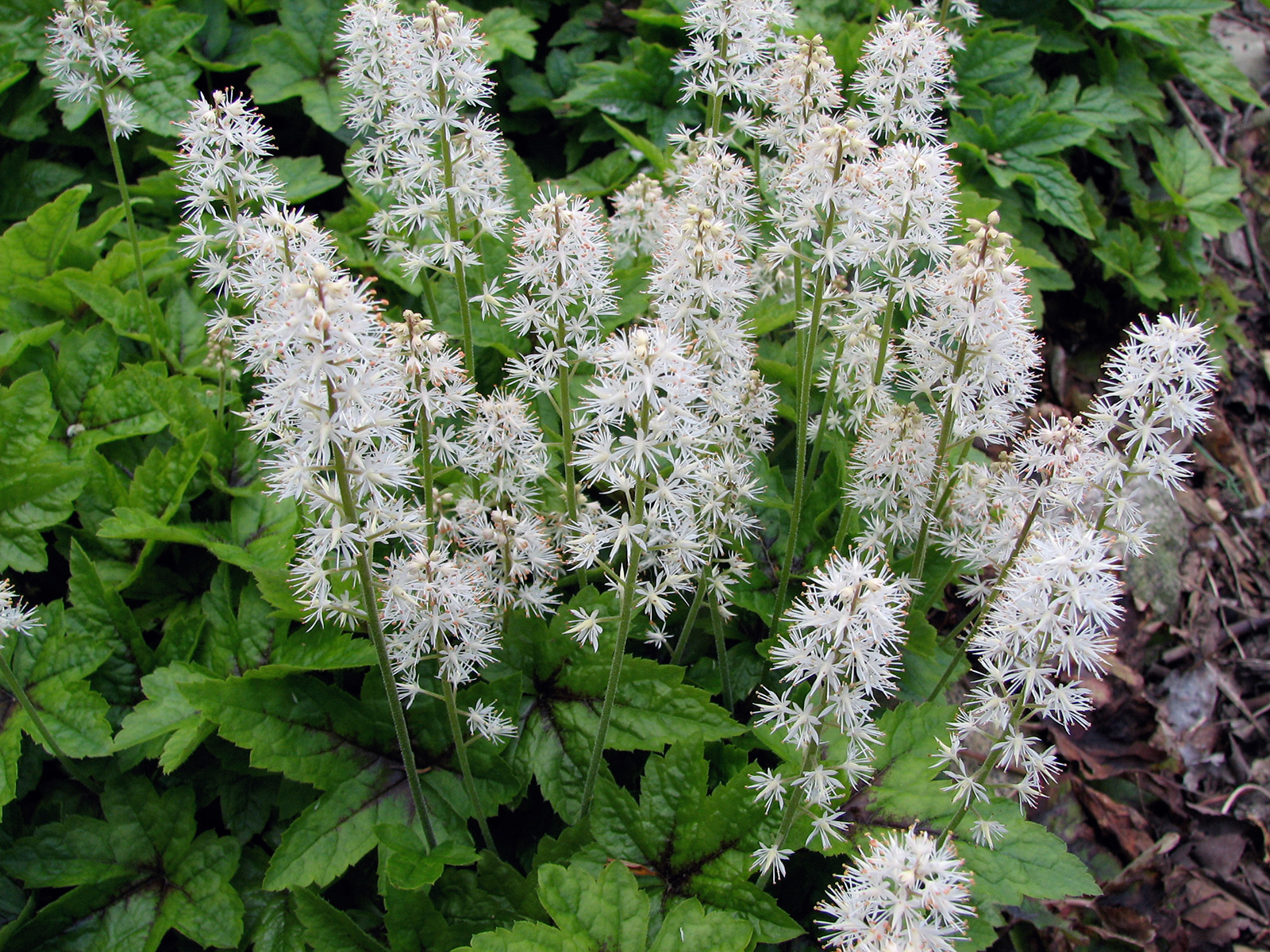
Another woodland-type area is in the front yard under the redbud tree. I started with just one or two of a number of different species, such as this foamflower (Tiarella cordifolia). I also have merry bells (Uvularia grandiflora), everblooming bleeding heart (Dicentra eximia), mayapple (Podophyllum peltatum), blue cohosh (Caulophyllum thalictroides), black cohosh (Cimicifuga racemosa), wild ginger (Asarum canadense), jack-in-the-pulpit (Arisaema triphyllum), bloodroot (Sanguinaria canadensis), goldenseal (Hydrastis canadensis), ferns, and others.
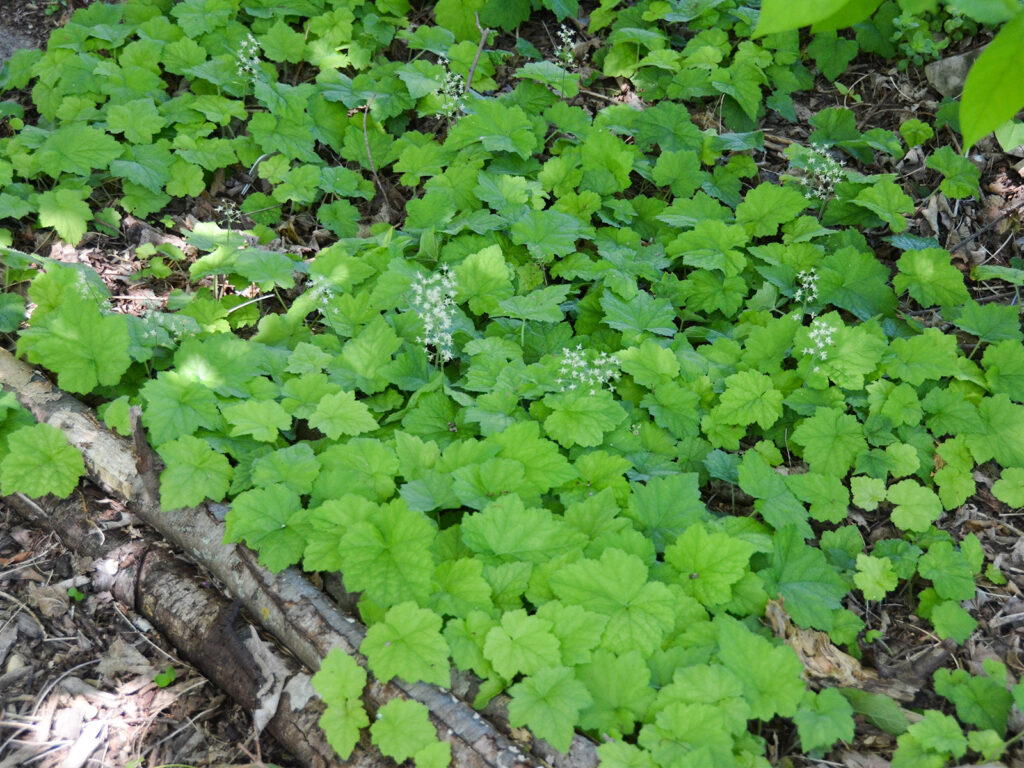
Planting just one of something really isn’t a recommended design technique, but it gave me a chance to see how different plants grow. Also, many of these are quite expensive ($6-$8 a piece), so I preferred to just wait for them to spread on their own or get big enough to divide. Most have spread quite nicely, such as this foamflower, which we enjoy while it’s flowering but even after flowering, its foliage is still very attractive. Others, such as merry bells, seem content to be a single plant, though increasing in size. (Or maybe there are seedlings I haven’t noticed.)
For a while I kept quite a few different (and expensive) cultivars of hosta left over from my ornamental gardening days. They served the purpose of easily filling space that would otherwise have been lawn. And though hosta are not native, they’re also not invasive, so it wasn’t a high priority to get rid of them. Still, when I needed space for new plants, I knew what to get rid of! By 2018, I had composted virtually all of them!
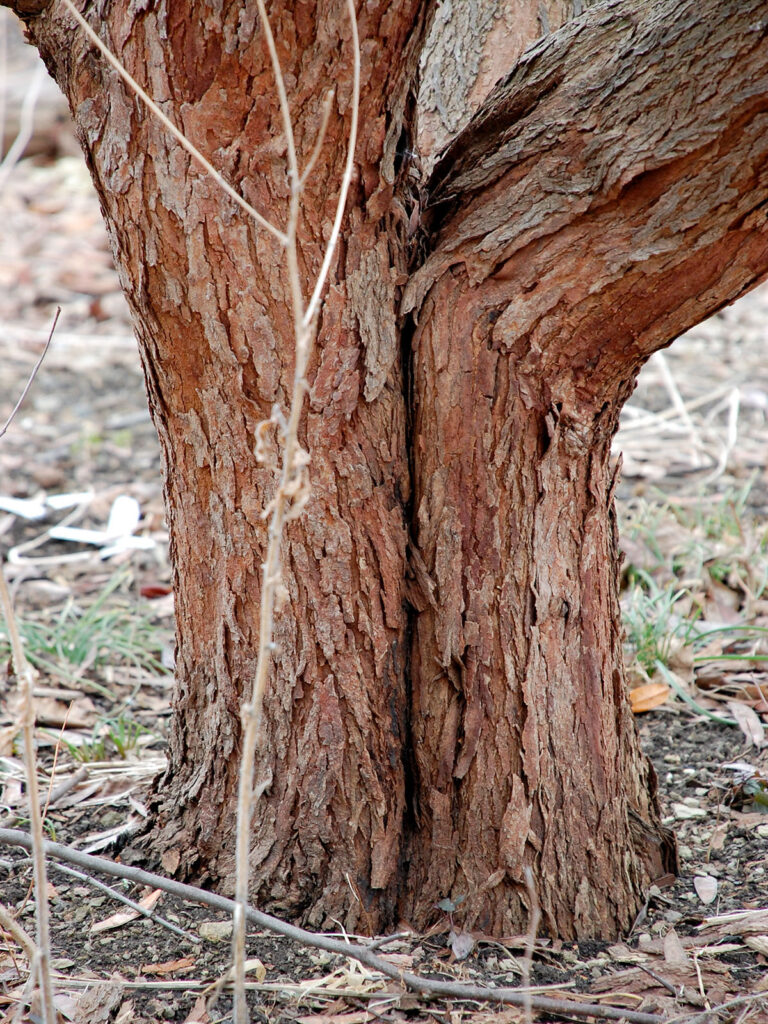
One dilemma concerning my front woodland garden illustrates another design problem. I had planted these shade-loving plants in the shade, but our neighbors then had to remove a dying tree that had provided much of the shade for this little woodland garden, so it isn’t as shady as it had been.
Compounding the problem is that our redbud tree, the remaining source of shade, seems unhealthy, too. It’s going to be tricky to replace the redbud without destroying the plants that are there, and also to provide some source of shade.
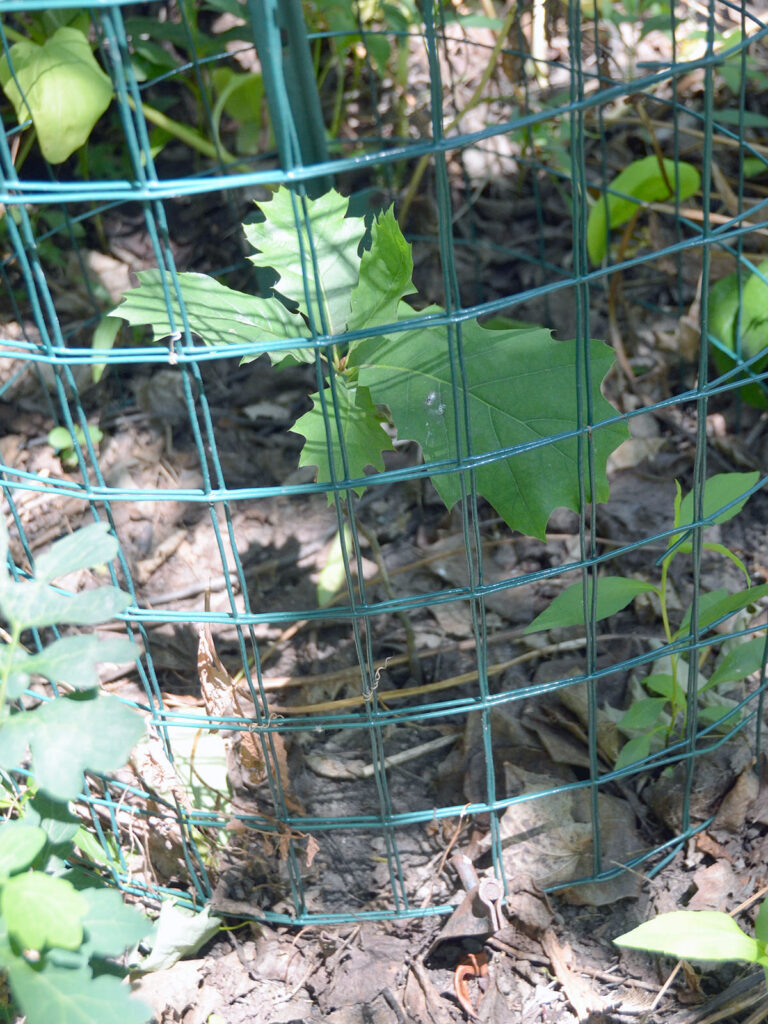
We planted this small oak seedling next to the redbud, in the hope that by the time the redbud dies, we’ll have a replacement — the best replacement, an oak!
Of course, we had to enclose the seedling in fencing to protect it from the deer.
Second front yard woodland
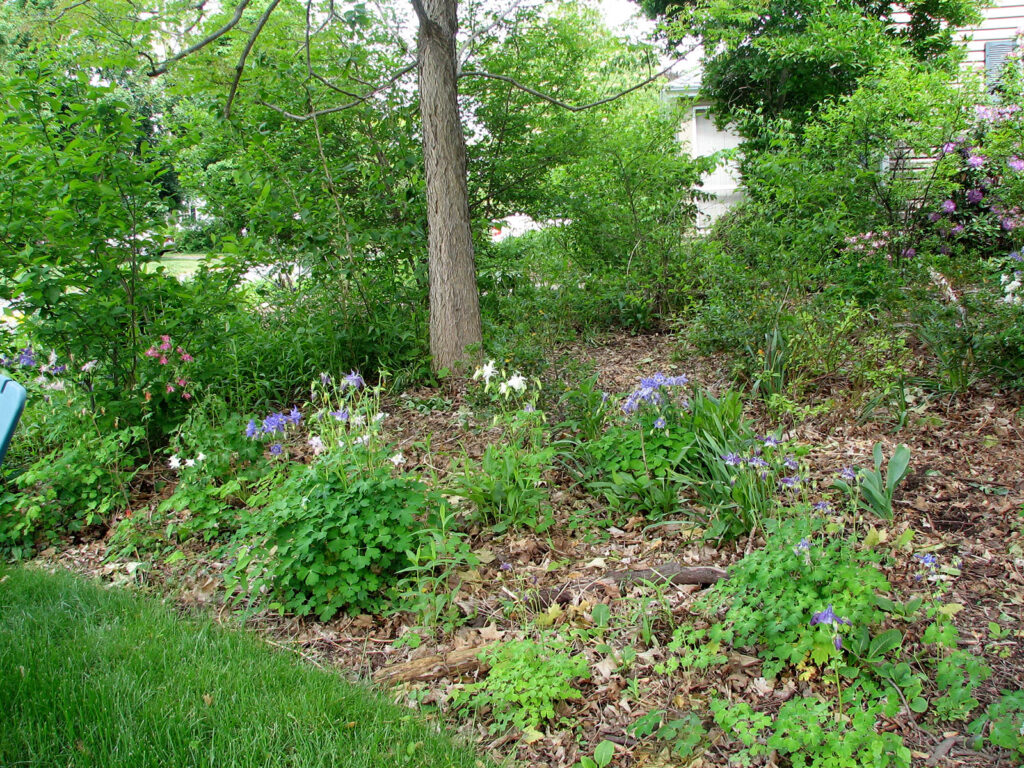
Our final woodland-type area is at the left of the sidewalk going to the front door, under our Kentucky coffee (Gymnocladus dioicus) tree. There are spicebushes (Lindera benzoin), a diervilla (sometimes called a native bush honeysuckle) (Diervilla lonicera), and a variety of columbines (Aquilegia) — some native, some hybrids, and some mixed since they interbreed with abandon — as well as some other flowers. We’re in the process of replacing the non-native columbines with native ones from our backyard.
Reflections
What one can’t see on a woodland walk is that a great deal of that wood is underground. Plunging below the forest floor, sometimes as deep as the trees are tall, a dense network of roots excavates the soil to a spongy consistency that holds up to 90 percent of rainfall, letting the accumulated water trickle only gradually toward low-lying wetlands. By comparison, as much as 90 percent of the rain falling on a lawn is immediately lost as runoff, and with it the soil’s mineral fertility.
~ Sara Stein, Noah’s Garden: Restoring the Ecology of Our Own Back Yards, 1993, p. 27
A natural woodland is composed of a multilayered tapestry of canopy and understory trees with a ground layer of shrubs and herbaceous plants. Trees of the same species are found at many different ages and irregular clusters, and do not necessarily have straight trunks and uniform heads. In fact, leaning and jagged trunks can often be the most interesting feature in the landscape.
Unfortunately, there is not enough space to create true self-sustaining woodlands on most residential properties. However, if the planting of site-appropriate native woodland species on the perimeters of suburban properties became commonplace, a series of continuous woodland corridors would be created, connecting existing isolated fragments of native forest badly in need of ecological interaction. The positive ecological impact of this would be quite significant, while the aesthetic advantages of suburban landscape in visual harmony with our native American forest would be easily apparent. Additional privacy would be a bonus.
~ Larry Weaner, Ten Elements of Natural Design
Surprisingly, silence is the most recently understood of the woodland services. Noise abatement studies designed to discover how best to mute the roar of traffic along highways have found that woodland leaf litter muffles sound better than any manmade barrier — or than the trees themselves.
~ Sara Stein, Noah’s Garden: Restoring the Ecology of Our Own Back Yards, 1993, p. 26
Woody plants have been called the “bones” of the garden, and you could say the same of their role in the wild as well. They are the structure that holds everything together, both physically and aesthetically.
~ William Cullina, Native Trees, Shrubs & Vines, p. 1
